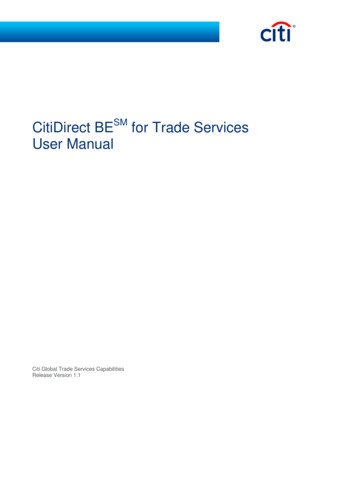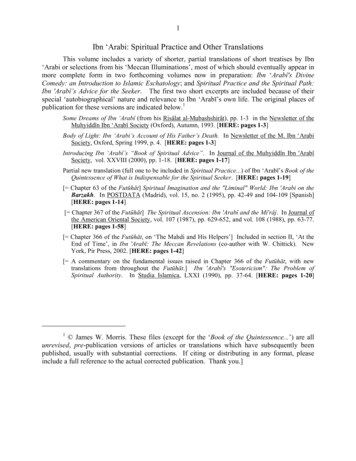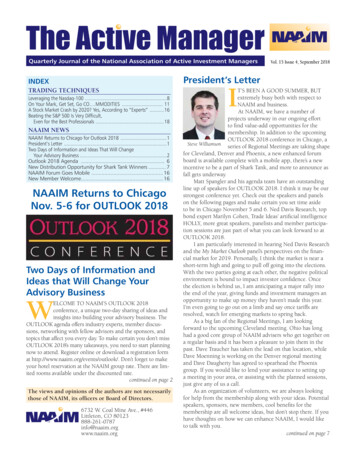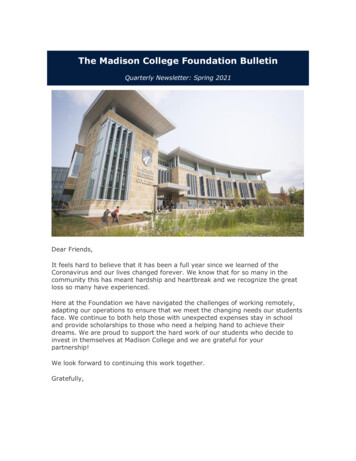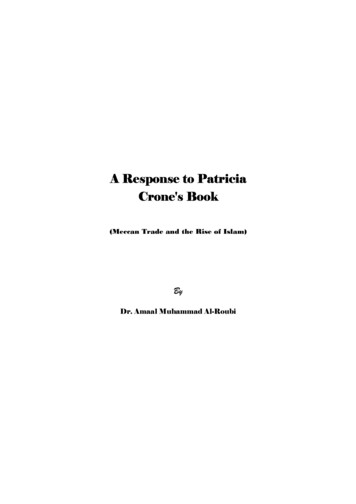
Transcription
A Response to PatriciaCrone'Crone's Book(Meccan Trade and the Rise of Islam)ByDr. Amaal Muhammad Al-Roubi
A Response to Patricia Crone's Book3In the Name of Allah the Most Gracious, the Most Merciful.IntroductionPatricia Crone's book Meccan Trade and the Rise ofIslam, Oxford, 1987 grabbed my attention, because ittackled an era connected with "The History of the Arabsbefore Islam", a course I am teaching to female students atthe Department of History, King Abdul-Aziz University,Jeddah.It is noteworthy that when I started reading throughthis book, I was really shocked by what I read between thelines and even overtly. What shocked me is that somethings were clear, but others were grossly incorrect andhidden behind a mask of fake historical research, thepurposes of which are obvious for every professionalresearcher. Therefore, as a scholar in the field, it wasnecessary for me to respond to this book so that readerswill not be deceived and misguided by the great errorsintroduced to them under the guise of historical researchor scholarship.Crone is an orientalist who raised somewhat cleverquestions, but her answers were misleading. Most of thetime, she deliberately used documented and logicalcoordination in order to prove the opposite of what hasalready been proven to be correct. It is a well-known factthat the easiest way to pass an illogical issue and to makereaders swallow it is to begin by an assumption whichlooks logical and persuasive, but is in fact essentially void.Then from this false assumption, you jump to a set ofconclusions in order to make your case logical andacceptable.
A Response to Patricia Crone's Book4Deception here lies in the speed at which falseassumptions are passed on skillfully and quickly so thatthe reader will not pay attention to the issue of theirvalidity. Thus, the reader will be easily persuaded toaccept the findings.This technique is followed in historicalstudies by some non-objective researchers. They insistedon a certain idea, and to prove this idea they look forevidence within a context which seems to be persuasive,but in fact lacks validity.Crone has changed and substituted some of thewords mentioned in historical texts. She introduced otherdetached texts, and intentionally ignored the sourceswhich contradict her opinions; otherwise, her idea wouldcollapse. Also, she stated conclusions without mentioningthe references she depended upon. Furthermore, sheaccused certain orientalists who disagreed with her oftrusting Islamic sources despite all their defects.This persistent endeavor on her part aimed atmisgiving "Surat Quraysh" and "The Battle of Badr". Thelater, according to the Holy Qur'an and other Islamicsources, took place in the month of Ramadan. She alsochanged actual historical locations; Mecca was changedfrom its well known geographical and historical location.She put the Ka'ba in the North of the Arabian Peninsula.Moreover, she claimed that Prophet Muhammad, peace beupon him (pbuh), appeared in "Balqa", in the farthestNorth of the Arabian Peninsula, despite her emphasis thatthe events related to the Prophet were predestined to takeplace in the South.
A Response to Patricia Crone's Book5I examined her many fallacies as an attempt to listthe most important issues for the purpose of deliberatelydeceiving and misleading others. In this study, I discussedall these issues stating the main themes as follows:First, is Crone's rejection of historical andgeographical facts claiming that the Holy City of Makkahis not situated on its original historical location. Shemoved the location of Makkah on the map therebyrejecting all indications made by Greek and Romanauthors to Makkah in the old ages.Second, is Crone's denial of the Pilgrimage toMakkah (the Ka'ba) before Islam. She claimed that theywent to three marketplaces near to Makkah: Ukaz, DhulMajaz, and Majanna. She did not explain hermitage beforeand in Islam, and in both cases she neglectedcircamumbation and Talbiay (the pronouncement made byPilgrims to Allah during Hajj). In most cases, shefabricated superficial logical coordination in order toprove the opposite of what has already been proven. Shedid not pay enough attention to the diverse sources whichcontradict and completely undermine her opinion,exploiting the lack of awareness of most European readersregarding the rituals of the Pilgrimage.Third, Crone refuses to recognize the role of Qurayshin the international trade of the Orient. She insists onmarginalizing and limiting Quraysh’s role to local areas.Often, she was about to recognize Quraysh’s internationaltrade, but intentionally refrained from doing so by usingvague sentences and without giving any explanation.Moreover, she completely rejected the explanations of
A Response to Patricia Crone's Book6scholars on Surat Quraysh, on which the internationality ofQuraysh’s trade before Islam was very clear.Fourth, Crone mistrusted the mission of the LastProphet, Muhammad (pbuh) by claiming that his missionappeared in the North of the Arabian Peninsula and not inthe Holy City of Makkah. She did this in order toundermine one of the most important bases of the Islamicmission which started from Makkah. She claimed thatQuraysh resided in the North of Hejaz, not in Makkah,though it is an undisputable and well-known fact thatQuraysh lived in Makkah.Fifth, there is great confusion in the history of thegreat Battle of Badr. She put aside the first Battle of Badr,substituted it with the second Battle of Badr which isknown as the “Nakhla Raid” and placed it instead of “TheGreat Battle of Badr” (the third battle). She did this inorder to match her work with the history which waswritten in Arabic on a papyrus. Papyrus was discovered inPalestine in 1956 and most of its letters were missing. Thisploy was not a slip; it was a deliberate attempt to raisesuspicions about the authenticity of the Holy Qur'an.Despite her confession that the Holy Qur'an did notundergo any changes,her discussions showed the opposite.Sixth, Crone misinterpreted the causes of successachieved by Islam in Madinah. She skillfully manipulatedthe spiritual problem (issues related to religion anddoctrine) in Arab countries before Islam. She claimed thatQuraysh did not play an important role in the service of theKa'ba before Islam; that Makkah was not conqueredpeacefully; and the success of the Islamic State was
A Response to Patricia Crone's Book7associated with invasion and Arab nationalism. Such ideasdid not exist in the seventh century A.D. when Islamappeared.Seventh, she committed mistakes when she referredto some Qur'anic verses, although it is obvious that she ishighly proficient in Arabic and made no mistake intranslating Arabic texts. Later, I will show readers howshe made mistakes when she referred to many verses ofthe Holy Qur'an. This means that this skilful historian hadcertain objectives and ulterior motives in her mind.Moreover, she used irony and sarcasm as a means topersuade readers; she used unacceptable words in herdescription of the Arabs. She trespassed all limits whenshe criticized Prophet Muhammad (pbuh). By using thisstyle, she disclosed her hidden agenda which affected herwork and, as a result, destroyed what could have otherwisebeen a respectable historical analysis.I will respond in details to what Crone hasintroduced in all these themes one by one. Furthermore,the kind of sources she depended on is well documentedand attached at the end of this study.There are several reasons for responding to Crone'sbook.First, I wanted to address non-Arabs and nonMuslims who have limited knowledge or harbourmisunderstanding about Islam and the Last Prophet(pbuh). I am not addressing Muslims because they arefamiliar with these topics and have no doubt about them.In addition, I want to refute the arguments of the enemiesof Islam who are happy with the blatant lies which were
A Response to Patricia Crone's Book8presented to them under the guise of scientific research,and who used the Internet as a forum in order to praise thiswork which was compatible with their vile intentions.It should be noted that after I published my replies toCrone's writings, she removed all her personal data fromthe Internet, with the exception of her e-mail. It seems tome that she did not expect the translation of her book,which I did with her permission, to be accompanied by adeliberate scientific study, and detailed accurate commentsnot only on every idea but on every single word shemisrepresented.Second, in addition to educated readers, Crone'sbook is a major reference for students who study thehistory of the Arabs before Islam in faculties of letters orother colleges at American and European universities.Therefore, I was over- cautious in responding to her inEnglish in order to unveil the mistakes she committed forthe purpose of discrediting Islam under the guise ofMakkan trade.Third, Muslim readers were shocked by the way theauthor counterfeited the facts for the purpose of reachingfalse and fabricated conclusions. Motivated by theirenthusiasm to defend Islam, those readers responded toher but without documenting their sources. This led me totackle this issue systematically using approved techniquessupported by corroborated evidence in accordance withthe methodology of scientific studies, aiming at unveilingthe suspect intentions and ulterior motivations of thisorientalist for all Arabic and English readers to see.
A Response to Patricia Crone's Book9Fourth, forewarning Arab readers, who are likely tobe impressed or trapped by this kind of Western thought,against unsuspectingly and unconsciously reiterating whatis presented to them. This doesn't mean that we should notread Western historians and scholars and not to learn fromdiverse schools of history. On the contrary, this is aninevitable issue, on condition that we read with a criticalmind and be able to judge historical facts in a deep,accurate and reliable way.In today’s world, some unfair scholars aim at effacingIslamic identity under the umbrella of globalization anddissolving Arabs and Muslims within the framework of thesweeping materialistic civilization, in addition to braindrain and superficial modernization. Hence, we have tokeep our eyes wide-open; we have to make active use ofour minds and intellect in order to identify the plots of thosewho attempt to abuse and rewrite our history. Also, weshould not be misled by the great names of historians,organizations,or universities.Our responsibility as historiansis to preserve our history and to refine it. Our language, ourhistory and particularly our religion Islam, form the mostimportant pillars of our identity. Moreover, dangers andmisfortunes threaten us from all directions by the forces thatbe.May Allah help us!In addition to what has been mentioned above,Crone indulged in many linguistic and methodologicalmistakes as follows:Although Crone is fluent in Arabic, she transliteratesArabic words into Latin letters intermittently. As a result,some letters from one word overlap with other letters from
A Response to Patricia Crone's Book10another word. This led to a change in the structure of theword.The confusion between the letters (b and h) led to agreat change in the structure and meaning, especially fornon- Arabic speakers.Islamic sources were devalued and referred to assecondary and tertiary literature, in spite of the fact thatthose sources constitute the primary major historicalsources and the data base for fruitful research. Croneshowed great interest and enjoyment when she found acontradiction between some accounts. She criticized thesources, but she refrained from going the next step. Inhistorical research, contradiction between the accounts ortexts does not mean that all accounts are untrue andunreliable. In the next logical but necessary step, theresearcher is obligated to analyze all accounts and texts inorder to be able to judge whether certain texts areacceptable, thers are rejected, some are improbable,certain texts are preferable, and others are valid andreliable.If there is a contradiction between two accounts, isthis an evidence against them? If this is the case, then ahistorian would be able to cancel the most important dates.At the same time, a historian would commit a mistake ifhe/she completely trusted the sources without scrutinizingthem. Crone intentionally committed mistakes when sherefused to accept contradicting texts without analyzingthem. In doing so, she can later on easily pass anyjudgment that suits her motivations in accepting orrejecting any opinion or text. She showed perseverance in
A Response to Patricia Crone's Book11examining the texts, but she consciously chose to distrustIslamic sources when they are in fact the primary sourcesto rely on.Fifth, we have to focus our attention on the necessityof reading all that has been written about Islam by nonMuslims, and we have to scrutinize and refine thesewritings. Allah has preserved Islam; in one way or anotherHe will guide someone to expose the plots against Islam.Muslims are not in a state of unawareness, as some tend tothink, and they will never continue to receive strikeswithout forcefully retaliating in defense of their sacredreligion which is the most precious thing they have.Sixth, I would like to express my thanks to all thosewho helped in the translation and publication of this work.May Allah bless all who serve the interest of Islam andMuslims.All Praise be to Allah, Lord of Worlds.Amaal Muhammad Al-RoubiKing Abdul-Aziz University
A Response to Patricia Crone's Book12Discussing the ThemesThe First ThemeMakkah: Name and Geographical LocationCrone said: "It is obvious that if the Meccans hadbeen middlemen in a long-distance trade of the kinddescribed in the secondary literature, there ought to havebeen some mention of them in the writings of theircustomers. Greek and Latin authors had, after all, writtenextensively about the South Arabians who supplied themwith aromatics in the past, offering information about theircities, tribes, political organization, and caravan trade; andin the sixth century they similarly wrote about Ethiopia andAdulis. The political and ecclesiastical importance ofArabia in the sixth century was such that considerableattention was paid to Arabian affairs, too; but of Qurayshand their trading center, there is no mention at all, be it inGreek, Latin, Syriac, Aramaic, Coptic, or other literaturecomposed outside Arabia before the conquests.This silence is striking and significant. It is sostriking that attempts have been made to remedy it. Thuswe are told that Quraysh are indirectly attested in Pliny'sDabanegoris region, that Ptolemy mentions Mecca underthe name of Macoraba, a name supposed to be reflected inPliny's portus Mocborbae, identified as Jedda, andAmmianus Marcellinus likewise mentions Mecca, this timeunder the name of Hierapolis. All these suggestions shouldbe dismissed out of hand.Dabanegoris cannot be constructed as Dbu BaniQuraysh, "the (area) pertaining to Bani Quraysh," as von
A Response to Patricia Crone's Book13Wissmann would have it.For one thing,such a constructionwould be South Arabian than Arabic, the language onewould have expected to be reflected here. For another,theexpression "Banu Quraysh" is impossible, Quraysh beingno patronymic: as a descent group Quraysh were BanuFihr. But above all, Pliny locates the region in question insoutheast Arabia, more precisely somewhere betweenOmmana and the Hadramawt; and the same is true ofportus Machborbae, as mentioned in the same passage.That places explicitly identified as southeast Arabianshould have been misconstrued as Quraryshi domainssays much about the intoxicating effect of Mecca on thesource-critical faculties of otherwise sober scholars.So does the identification of Ptolemy's Macorabawith Mecca, which has gained almost universalacceptance. It was first made on the ground; the nameswere vaguely similar and the location vaguely right,Macoraba being assumed to reproduce a name such asMakka-Rabba, "Great Mecca." But this is a mostimplausible construction, which has since been replacedby makrab or mikrab, meaning temple. But in the firstplace the root krb doesn't denote holiness in Arabic, asopposed to South Arabian, so that once again thelanguage reflected would not be the one expected.”Then she continued: “In the second place, a namecomposed of the consonants mkk cannot be derived fromthe root krb. It follows that Ptolemy would be referring toa sanctuary town which was not called Mecca. Why thenidentify the two? Rescue attempts such as mikrab Makkah,"the sanctuary of Mecca," are no better than Makka-
A Response to Patricia Crone's Book14Rabba, for all that we clearly need some sort of additionto account for the feminine form reflected in the Greek.The plain truth is that the name of Macoraba hasnothing to do with that of Mecca, and that the locationindicated by Ptolemy for Macoraba in no way dictatesidentification of the two. If Macoraba was located in anArabic-speaking environment, its name is more likely toreflect an Arabic form such as Muqarraba than aderivation from South Arabian krb; if it was locatedamong speakers of South Arabia, it cannot have been thecity of interest to us; and if Ptolemy mentions Mecca atall, he calls it Moka, a town in Arabia Petraea. Naturally,there is no Mecca in Ammianus Marcellinus."1The above stated opinion can be refuted as follows:First, it is dangerous to establish historical factsdepending on a linguistic assumption which is open to allprobabilities.Moreover,Crone laboriously tried to overlookthe reference made to Makkah by three Greek and Romanwriters, namely: Pliny the Elder who wrote in the firstcentury2; Ptolemy, the Alexandrian geographer who wrote1 Partricia Crone, Meccan Trade and the Rise of Islam, Oxford, 1987,pp. 134-136.2Pliny the Elder (23/24-79 A.D) wrote many books: A biography of someimportant figures in the Roman society, Roman wars against Germans, TheArt of Rhetoric which consists of 31 parts. Naturalis Historia is his mostimportant work. It consists of 102 parts. This great encyclopedia coversgeography, human races, psychology zoology, botany, pharmacology, andmineralogy. This encyclopedia consists of 2000 books, out of which 100books were written by Greek and Roman scholars.Cf. Al-Roubi, Amaal Muhammad “Arab Peninsula in the Writings of theGreeks and the Romans and the Rise of Mecca a Sacred City in their
A Response to Patricia Crone's Book15in the period of 121-150 A.D.1; and the historianAmmianus Marcellinus from the fourth century A.D.2.Writings”, Association of History and Archeology, Journal in GulfCountries, No. 6, 1426 (2005), pp. 82, 98, 99.Cf. Pliny the Elder, Oxford Classical Dictionary, Oxford 1957, pp. 704.1Claudius Ptolemaeus was born in Ptolemi in Upper Egypt. He is anAlexandrian scholar. He wrote in the period of 121-151 AD. He wrote manyscientific books, in which he combined the studies of math, astrology, nature,and geography. His book Mathematike Suntaxis σϋνΤταξίς "Μαθηµατικήknown as (the great compiler), another book about ( Cross Vertical Angles)and a third one about Stereographic; a fifth about “optics "which isconsidered as the first attempt for rays refraction theory. GeographyΎΦήγήσις ωγραφικήεΓ"is his most famous book. It consists of eight parts inaddition to an atlas which includes the world map.Ptolemy did not depend only on astrology, but also on the reports sent bytravelers to Alexandria. When he sketched the world map (a copy of which isunavailable for us), he left a space in the western part of it; believing in theexistence of continents other than Europe, Asia, and Africa which wereknown at that time. The Arabian Peninsula is a part of the fourth and seventhmaps of Asia. Ptolemy cited a series of long lists of tribes and areas names,and geographical names along the coasts starting from the top of the Red Seato the Arabian Gulf. He also mentioned names of cities, villages, and gulfs. Inaddition, he listed the names of more than one hundred cities and villagesmany of which were mentioned for the first time in the sources of the ancientworld. This work is one of the most accurate books of geography in theancient world. Cf. Al-Roubi (Amaal Muhammd), Arab Peninsula in GreeksWritings, pp. 86-101; Oxford. Class. Dict, p. 746; Al-Roubi, AmaalMuhammd, Egypt in the Roman Era, A Socio-Economic Political Study inthe Light of Papyri Documents, 30 BC-284 A.D., Jeddah, 1404 (1984), pp.262-271.2Ammianus Marcellinus was born in a rich family at Antioch, Syriaaround 330 AD. He is considered to be the last of the great Roman Historians.His work Rerum Gestarum which he wrote in Latin covered the period 78378 AD. The first thirteen books of this work were lost, and the books 14-31formed an uninterrupted account of the events from 353-378 AD. He had
A Response to Patricia Crone's Book16Crone rejected Pliny’s view because in her opinionQuraysh being no patronymic:As a descent group Qurayshwere Banu Fihr. But the reality of the situation is quite theopposite.Quraysh is a name which refers to thedescendants of Banu Fihr. Historians agree that the tribe ofKinanah, to which Qussai Ibn Kilab belongs, is the originof Quraysh. The final say in this issue is what the Prophet(pbuh) said: “We Banu Al-Nadhr are from Kinanah” andthe Prophet (pbuh) did not go past Adnan when he talkedabout his lineage1.Despite the fact that there are differences amonghistorians about the lineage of Adnan, there is a consensusamong them that Adnan's lineage ends with Ismail (pbuh).This means that Quraysh has its deep roots in Makkahsince that distant era. According to the resources availablefor us, we cannot specify when this branch of Kinanahwas called Quraysh; whether this was a name of a person;or a characteristic of one of their famous men. I tend tosupport the idea that the name of Quraysh was derivedfrom the Arabic word “Taqarush” which means gainingmoney by working in trade instead of raiding and lootingother tribes.2likely finished his work about 391 A.D. He was sharp-witted, neutral andobjective in his evaluation of the events. Moreover, his great knowledge aboutLatin books, which he cited many times showed, that he was highly educated.Cf. Al-Roubi, Amaal Muhammd, Arab Peninsula in Greeks Writings, pp. 8990-102; Oxford. Class. Dict, p. 430.1Ibn Sa'ad, Al-Tabaqat Al-Kubra, Part 1, p. 47.2Ibn Hisham, Abu Muhammad Abdulmalik Al-Ma’afri (died 213 H.),The Prophet’s Biography, edited by Mustafa Al-Saga and AbdulhafeezShibli, Part 1, Beirut, No date, p. 93; Al-Tabri, Abi Jaafar Muhammad Ibn
A Response to Patricia Crone's Book17Quraysh became important in trade in the first orthird centuries A.D. This conclusion is supported by aSouth Arabian inscription which dates back to the era ofthe Hadhrami King (Chatramotitae) Al-Iz Ibn Al-Iz Yaltwho ruled either in the first or in the third century A.D.The inscription stated that the king received delegationsfrom Qrashtan in his inauguration at Anood Castle. Alongwith them there were representatives from Palmyra, Kazd,Chaldaens, and India. From the nationalities of thesedelegations, it seems that this gathering had a connectionwith trade. This can be attributed to the role Hadramawtplayed in Arab incense trade in old ages. Hadramawt wasone of the most important producers of the best kinds ofincense1.Second, there is no reference whatsoever to the socalled Dabanegoris region in Southern Arabic in theJareer (died 310 H./923AD), History of Apostles and Kings, edited byMuhammad Abu Alfadl Ibrahim, Volume 1, Part 1 and 2, Beirut, no date, Part1, p. 64. Concerning various explanations of the name Quraysh, cf. Salama,Awatif Adeeb, Quraysh before Islam, its Religious, Economical andPolitical Role, Riyadh, 1414 H./1994 AD, pp. 38-41; Shahbehai, JihanAbdurrahman, The Role of the Honorable Mecca in the Economical Lifebefore Islam, A Study of the Period between the Sixth and SeventhCenturies AD, Unpublished M.A. Dissertation, Jeddah: King Abdul-AzizUniversity, 1420/2000, pp. 20-22. Roman Era, A Socio-Economic PoliticalStudy in Light of Papyri Documents 30 BC-284 AD, Jeddah, 1404 (1984), pp.271-272.1Quraysh delegation consisted of fourteen women, of them Khadija,Asma’a, Hind, and others, whereas every other delegation was represented bytwo women. Concerning the inscriptions cf.: Yamme, A. Editor andTranslator. The Aluqla Texs (Documentation Sud-Arabe) Washington D.C.1963. pp. 38-44, and Mahran, Muhammad Bayoumi, Studies in the Arabs OldHistory, Riyadh, 1397/1977, p. 407; Salama, op. cit., p. 40.
A Response to Patricia Crone's Book18archeological resources or in the writings of the Greeksand the Romans. Also, there is no sea port called PortusMochorabae in this area, or an area called Macoraba.Third, it is very easy to refute the statement that thenorthern linguistic construction should be Dhu BaniQuraysh and not Dabanegoris, as mentioned by Pliny. Onone hand, the difference between the two forms is verymarginal and it can be easily interpreted depending onmeans of communication in the first century A.D. On theother hand, differences are likely to take place intransliteration of names from Arabic into Latin.Fourth, concerning the city of Moka, it does exist inPetra in the Arab state of Anbat in the farthest north of theArabian Peninsula as Crone mentioned; but it is an inlandcity and has no seaports. Pliny learned a lot about this cityfrom his contemporary Strabon, the geographer. He wrotewhat he knew about this in his Geography. He also visitedthis city and stayed in Petra at the time when the Romanswere preparing for their campaign against Yemen in theyear 26/27 B.C. Three years after, they wiped outKleopatra the last of Macdoniac Ptolemic dynasty whoruled Egypt from 323 to 30 B.C. It is also possible that theAnbat tribes which migrated to this area at the top of theRed Sea and settled there were originally from Hejaz.They started to ship Arabic and Oriental goods to Gazaand Renoclora (Al-Areesh) seaports on the Mediterranean.It is probable that they named their city Moka after theHoly City of Makkah as a good omen. Some Arab tribeswere accustomed to this habit of giving the name of theplace they came from to their trade centers along the traderoute extending from farthest south to farthest north
A Response to Patricia Crone's Book19western of the Arabian Peninsula, such as “Maeen” and“Sheba” in the north. Greeks and Phoenician did the samewhen they established their trade centers in theMediterranean in the seventh century B.C.Fifth, the argument that Pliny put Dabanegoris portin South Arabia, precisely in an area between Oman andHadramawt, is completely untrue. Pliny was talking aboutthe Arabian Gulf and he said he would describe the coastfrom Charax to Gerhha to Ommanna to the other coasts onthe Persian Gulf (Chapter six, paragraph 149). Then hetalked about Southern Arabia with its Hadhrami and Shebaincense. But Dabanegoris and Mochorbae ports attractedhis attention. These ports are most likely the Al-Shua’biaport which is not far from the present port of Jeddah.Therefore, he talked about them in paragraph 150. Thismeans that it is Crone who says that Mochorbae port issituated in an area between Oman and Hadramawt, butattributed this to Pliny. In addition, no one heard of such aport in the southern part of the Arabian Peninsula.Sixth, it is not scientifically acceptable to keepreiterating that vague names are similar and vague placesare real; similarity should be based on scientific facts.Seventh, claiming that Macoraba is derived fromMakka-Rabba which means great Makkah is untrue. Thecorrect translation is “Lord’s Makkah” or “Allah’sMakkah”; because the root “mkk” consists of consonantletters meaning “house” in Babylonian and “Rabba”meaning “the Lord” or “Allah” in Southern Arabia, that is,“Allah’s House”. This linguistic structure is a possessiveform and not a derivative one.
A Response to Patricia Crone's Book20Eighth, names of many old cities and countries donot reflect the language of their people. For instance,Egypt is a Semitic name meaning “the dividing borderbetween two lands". Egypt is also derived from the Greekword Aeguptus meaning the “black land” or the fertileland1. If then the Arabic name of Egypt is of a Semiticorigin, its name in modern European languages is of Greekorigin. Does this mean that old Egyptians spoke theSemitic Language or one of its branches? In the same way,did Egyptians speak Greek in Pharaoh era before Greeksstarted the first chapter of their history?Based on the same logic, how can we interpret thename of the city “Thebes” in the western part of Greece inold ages? Did Egyptians establish this city and call it“Thebes” - now Al-Uqssur - the capital city of Egypt inthe 15th century B.C. Therefore, it is very difficult to find1The name of Egypt (MIsr) appeared in the fourteenth century B.C. in“Tel Alamarna” documents when “Rabaadi”, Prince of Jubeil, wrote toPharaoh that because of the threats of his neighbors he might be compelled tosend his family to (Mato Misri) which means Egypt. Also the names of Mishriand Missri were mentioned in a Mitanic board; the name Misr was mentionedin a text from Ras Shamra; the name Misrem was mentioned in a Phoeniciantext which dates back to the early period of the first millennium B.C.; theAssyrians knew Egypt as Missro or Missr; the Aramaeans knew it asMissreen; in the Torah it was mentioned as Missr or Missrayem which referssometimes to the country and sometimes to the people. The correct name“Missr” is mentioned in the holy Qura’n in the following Suras: Surat AlBaqrah (61); Surat Yunus (87); Surat Yusuf (21:99). Cf. Mahran, MuhammadBayoumi, Egypt and Old Near East, Alexandria, Part 1, 1409/1988, pp. 2124; Saleh, Abdul-Aziz, Civilization and Archeology of Old Egypt, Part1,Cairo,1962, pp. 2-6.
A Response to Patricia Crone's Book21an accurate explanation for the names of places in
Patricia Crone's book Meccan Trade and the Rise of Islam, Oxford, 1987 grabbed my attention, because it tackled an era connected with "The History of the Arabs before Islam", a course I am teaching to female students at the Department of History, King Abdul-Aziz University, Jed

